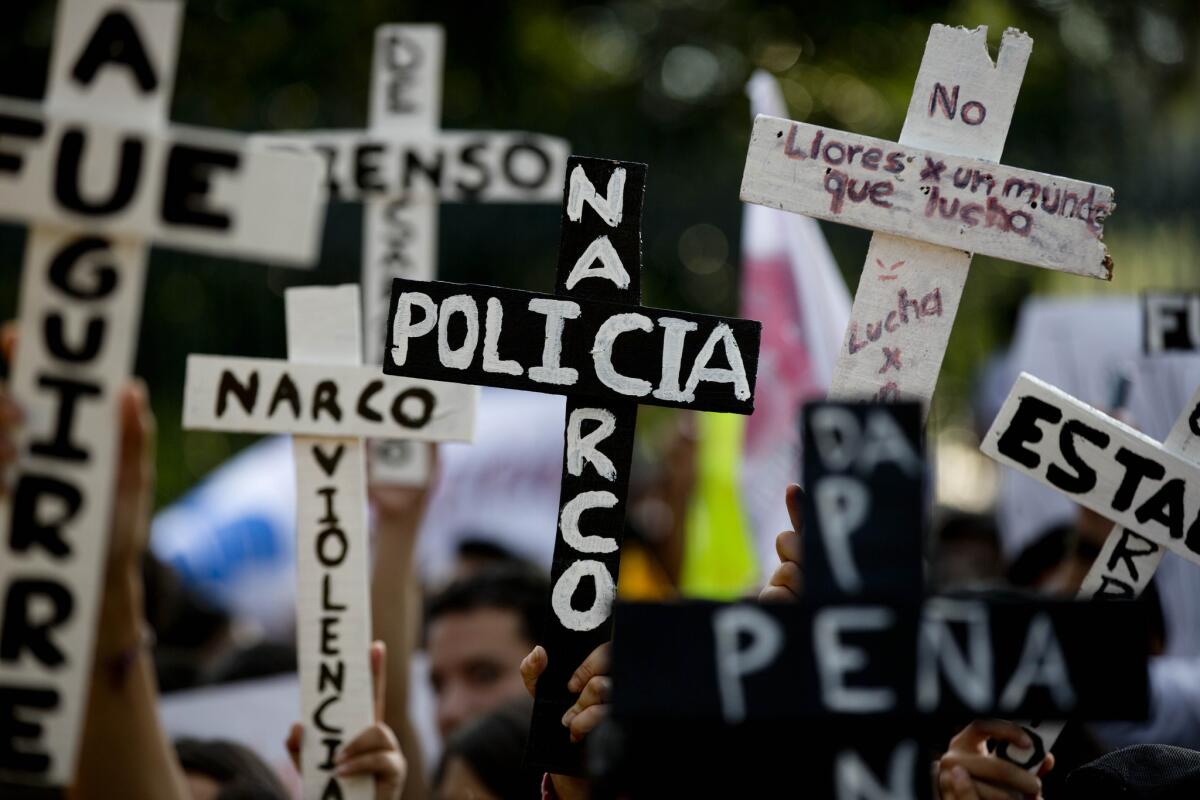Burned bones and other remains may belong to missing Mexican students

- Share via
Reporting from Mexico City — Mexican investigators have recovered black plastic garbage bags containing dozens of burned human bones, ashes and other remains they believe may belong to 43 college students last seen being led away by police nearly a month and a half ago.
The remains match information from three detained suspects who described in great detail how they loaded the students in the back of two cargo trucks, killed them, burned and chopped up the bodies and tossed them in bags into a river, Atty. Gen. Jesus Murillo Karam said Friday.
The evidence “points to the homicide of a large number of people,” he said. He stopped short of declaring the dead to be the students, however, saying the condition of the remains will make identification difficult.
Murillo Karam met earlier with the students’ parents to brief them on what he called “very regrettable” findings. The remains were found along the river in Cocula, in Guerrero state, and near where the students were captured in the city of Iguala, about 120 miles south of Mexico City.
Authorities have said they believe the students were intercepted by police from Iguala and Cocula, transported to a deserted area between the two towns and handed over to a local drug gang. The remains were found in the area where that exchange would have taken place.
Murillo Karam has said the order to intercept the students came from Jose Luis Abarca, then the mayor of Iguala, who feared they would disrupt a party his wife was presiding over. Abarca and his wife, Maria de los Angeles Pineda, were fugitives until their arrest this week. More than 70 people, many of them police, have been arrested so far.
Murillo Karam’s presentation offered the most clear-cut description to date of what probably happened to the students, freshmen from a rural teachers college for the poor.
Still, the attorney general met with hostile questions from journalists who evinced skepticism over why it took so long to find the remains. Parents, too, in recent weeks have resisted believing the government versions of what happened, questioning whether it wouldn’t take a large group to overpower 43 students.
“For us, as long as there is no proof, our sons are alive,” one father, Felipe de la Cruz, said at a news conference held by the parents at the rural college in the town of Ayotzinapa, following Murillo Karam’s presentation.
However the case is resolved, it has already exposed the deep penetration of criminal gangs in local police agencies and political leadership in Guerrero state and beyond.
Murillo Karam showed video confessions from three suspects who reenacted how they transported the students -- some died from suffocation piled in the back of a truck, one suspect said -- killed them and disposed of the bodies.
The fire to burn the bodies lasted from midnight of Sept. 26, just hours after the students were kidnapped, until midafternoon the next day, one of the suspects said. The bodies were piled with branches, tires and trash and gasoline and diesel were then poured on and ignited.
Teeth found among the remains were so badly burned that they practically “turned to powder” when touched, Murillo Karam said.
“What I can tell you with certainty [is that] there was a homicide of many people,” he said at the much-anticipated, hourlong news conference. “The statements of [the suspects], the work of the experts, what they found in each one of the tombs, the certainty of where the garbage bags were … I have no doubt that there was a mass homicide.”
Now, he added, “I have to do everything in my power to identify [the remains] to know if these were the students.”
Follow @TracyKWilkinson on Twitter for news out of Mexico
More to Read
Sign up for Essential California
The most important California stories and recommendations in your inbox every morning.
You may occasionally receive promotional content from the Los Angeles Times.













